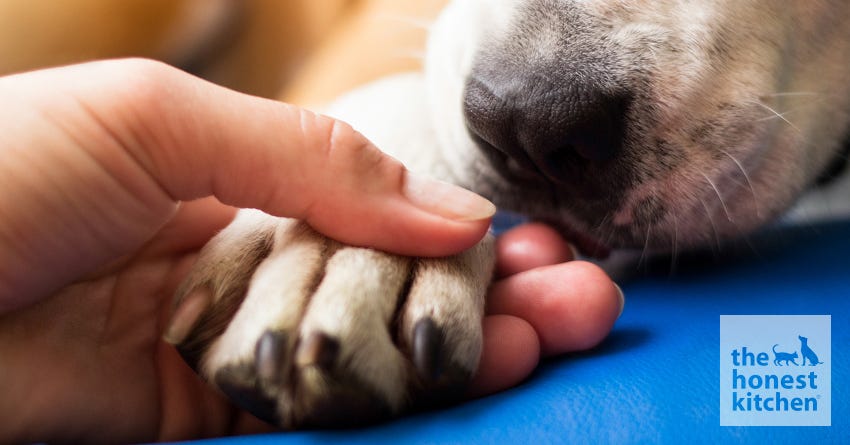Most of us know people who have to be careful about what they eat. A friend’s son doesn’t tolerate cow’s milk, while a co-worker can’t be anywhere near a peanut. Unfortunately, pets can have problems with certain foods and ingredients just like people do.
If your dog or cat is having mystery symptoms like itchiness, redness, greasy skin, bloating, vomiting, or diarrhea, a food allergy or intolerance could be to blame. This helpful guide will show you how to identify allergies in pets, recognize trigger foods, and create an effective elimination diet for your cat or dog.
Quick Navigation
- Food Allergies, Food Sensitivities, and Food Intolerances in Dogs and Cats: What’s the Difference?
- Common Foods That Cause Allergic Reactions in Pets
- Signs and Symptoms Your Pet Might Have Food Sensitivities (and Need an Elimination Diet)
- How Is a Food Allergy or Sensitivity Diagnosed?
- What Is an Elimination Diet for Pets?
- How to Execute an Elimination Diet Plan for Pets (5 Steps)
- Pet Elimination Diet Best Practices
- Final Things To Keep in Mind
- Try Our Limited Ingredient Foods for Pets With Sensitivities
Food Allergies, Food Sensitivities, and Food Intolerances in Dogs and Cats: What’s the Difference?
While the term “food allergy” is used widely by veterinarians and pet owners, this type of reaction is actually rare. For instance, it’s estimated that only 10% of dog allergies are food allergies, and in cats, food allergies rank third after inhalant allergies and flea bite allergies.

Many pets who are described as having food allergies actually have a food sensitivity or intolerance — a less severe problem, but still troubling for the pets and pets owners dealing with them. Let’s inspect the differences below.
What Are Food Allergies in Pets?
Food allergies are genetic and may show up in the first few months of your pet’s life or during their adult years. When your pet is exposed to their trigger foods enough times — just once or sometimes after years of eating it — their immune system launches an immediate response.
The response may be mild (itching, rashes, sneezing, bloating, loose stools) or life-threatening (anaphylaxis, which can include swelling of airways, vomiting, rapid pulse, dizziness, loss of balance, blood pressure drops, loss of consciousness, and shock).
One of the most common symptoms of a food allergy in dogs and cats is skin itchiness or “allergic dermatitis.” It can occur on the face, ears, front legs, paws, and around the anus, sending pets into desperate bouts of chewing and licking at their skin. Chronic ear infections, hair loss, and skin infections may also crop up due to the irritated skin and stress. (We’ll cover more signs and symptoms later on.)
Some cat and dog breeds are more affected by food allergies than others. Many veterinarians report seeing Rex cats, Retrievers, German Shepherds, Cocker Spaniels, Rat Terriers, and West Highland White Terriers most often. However, any pet, purebred or mixed, can develop food allergies.
What Are Food Sensitivities and Food Intolerances in Pets?
Food sensitivities and intolerances are reactions by your pet’s digestive system — not their immune system — to certain trigger foods. Sensitivities are more common than food allergies and generally aren’t as serious as true food allergies.
They’re often mislabeled as allergic reactions because they cause similar symptoms. This includes itchiness and redness, but gastrointestinal (GI) issues like obvious discomfort, abdominal cramps, bloating, vomiting, and diarrhea may happen too.
A major difference between a sensitivity and allergy is the length of time it takes for your dog or cat to have a reaction. Symptoms of an allergic reaction tend to appear rapidly (sometimes within minutes) after food exposure. An intolerance reaction, on the other hand, may not appear for several hours since the food needs to work its way down the digestive tract.
Recommended Reading: Why Your Cat Has a Sensitive Stomach
Common Foods That Cause Allergic Reactions in Pets

The root of your pet’s problems may be ingredients that are very common in dog and cat food products, which we’ve listed below:
Carbohydrates (Grains and Starchy Vegetables)
- Wheat
- Soy
- Corn
- Rice
- Sugar beet pulp
Proteins
- Beef
- Lamb
- Chicken
- Eggs
- Dairy products
In addition, high-risk ingredients like preservatives, additives, animal by-products, and cheap fillers may be causing issues. They often appear in pet food with poor nutritional quality and can potentially weaken your pet’s immune system over time.
A helpful first step toward combating food sensitivities may be to switch your pet to a grain-free diet and then try different proteins to see if you can pinpoint the cause.
Signs and Symptoms Your Pet Might Have Food Sensitivities (and Need an Elimination Diet)

Every animal is different, so your cat or dog may have all or a few of these food sensitivity symptoms. See if any of the issues below sound familiar.
Itchy Skin or Redness
While itchiness and irritation can be brought on by other things like fleas and contact allergies, food sensitivity is a leading cause. If your dog or cat’s itching has gone on for a while, think back to when you last switched their diet.
It’s also a good idea to check the label on their food and treats to see if the manufacturer changed their formula without you knowing it. Some other skin-related signs include a greasy coat, a dry, brittle coat, and dandruff.
Licking and Chewing at Their Body
Excessive licking of the neck, toes, paw-pads, ears, or rear is a classic sign of a food allergy or sensitivity in both dogs and cats. It’s a natural instinct to soothe inflamed and irritating skin. This itchiness could be caused by a specific ingredient or may be a reaction to an overload of multiple hard-to-digest ingredients in their food.
Frequent Digestive Problems
Stomach cramps, bloating, excessive gas, chronic diarrhea, and food regurgitation can be a sign of food intolerance. Your pet’s body may be trying to quickly expel the food ingredient that’s causing problems. Rather than relying solely on medications or supplements to try to reduce the symptoms, go straight to the source and look at their diet.
Ear Infections
Signs of an ear infection in pets include head shaking or tilting, general redness of the ear flaps, lack of balance, and a a different or bad ear odor. If there’s a buildup of waxy, dark, yeasty-smelling debris in the ears, it may be due to a yeast overgrowth caused by an excess of refined carbs in your pet’s diet.
Tiredness
Of course, pets become a little slower as they age. But if your favorite feline or canine seems less enthused about life in general, seems disinterested at meal time, or can’t keep up with their friends, it could be a sign that something in their diet isn’t sitting right. An ingredient in the food may make them feel uncomfortable after eating or cause fatigue and lethargy, just like gluten intolerance can in humans.
How Is a Food Allergy or Sensitivity Diagnosed?
Right now, the best way to diagnose food allergies or sensitivities is to do an elimination diet, also known as a food trial, to discover which ingredients are causing problems.
This is for a few reasons. First, skin-patch tests and blood tests aren’t yet a reliable way to diagnose food allergies. Second, several health issues and everyday incidents have the same symptoms as food allergies. For example, inhalant allergies from pollen and mold can cause itching, swelling, trouble breathing, and so can a bee sting or a strongly scented candle.
If you suspect your pet is dealing with food-related issues, your vet will want to do a thorough exam to rule out other causes and treat any other issues before dealing with the possible allergy. Once that’s taken care of, your vet will likely recommend an elimination diet.
What Is an Elimination Diet for Pets?
In an elimination diet, you take your pet off all the foods they’re currently eating and give them a strict diet of two foods they’ve never eaten before.
You or your vet will choose one new protein and one new carbohydrate — like rabbit and quinoa, venison and barley, or buffalo and millet — and stick to those foods exclusively for at least 12 weeks. That means no other foods, treats, chews, toys with food, flavored toothpastes, supplements, and so on, or you’ll have to start over, and no one wants that! Ask your veterinarian about any medications your pet is taking as well.
At the end of this trial period, your vet will ask if your pet’s allergy symptoms have changed, lessened, or disappeared. What happens next depends on your pet’s progress:
- If the symptoms haven’t gone away, the problem likely isn’t a food allergy, and your vet will suggest other possibilities.
- If the symptoms have improved a little but aren’t gone completely, your vet might suggest a second food trial with a different protein and carb.
- If the symptoms have disappeared, then your vet will have you reintroduce one new food at a time, usually one per week, and watch for reactions. If your pet reacts, which usually takes days or weeks, you stop feeding them that food, and eureka! You may have found a source of their food allergy or sensitivity.
Finding one trigger food doesn’t mean the diet is over, as many pets are sensitive to more than one food. Your vet will likely have you keep going down the list of common proteins and carbs like beef, chicken, turkey, fish, wheat, corn, and so on, to see if there are any other culprits.
How to Execute an Elimination Diet Plan for Pets (5 Steps)
If you think an elimination diet plan is right for your dog or cat, here’s a brief overview of what it will look like:
Step 1: Begin With a 50/50 Diet
Meet with your vet and decide on two foods, one protein and one carbohydrate, that will make up your pet’s 50/50 diet. Plan to feed these foods for at least 12 weeks, although some vets recommend a 16-week elimination diet to start.
Step 2: Observe and Take Notes
It’s a good idea to keep a detailed food journal during this time to record things like how much your pet eats and how they’re feeling and acting throughout the 12 weeks. If your dog or cat has any serious negative reactions, like trouble breathing or loss of consciousness, tell your vet or get emergency care right away.
Step 3: Start Adding in Simple Foods
After the trial period is up and conditions are improving, your vet may give you the green light to slowly add foods back to your pet’s diet. They may suggest starting with a protein like turkey or fruits and vegetables like sweet potatoes and bananas.
Step 4: Record What Happens
Continue taking notes in your food journal. If there’s a flare-up or recurrence of previously improved symptoms at any point, your pet may not be able to tolerate that food. Tell your vet, remove any new ingredients from that week, and try something different.
Step 5: Craft a Safe and Healthy Diet for Your Pet
Finally, take all your findings and turn them into a healthier, safer diet for your favorite feline or canine. Once you’ve identified any problem ingredients, it should be easy to either find a commercial pet food with limited ingredients or recipes to prepare safe meals and treats at home.
Pet Elimination Diet Best Practices

For an elimination diet to work, your pet has to stick to their diet every single day. Here are some tips that will make the food trial period as smooth as possible for you and your pet(s).
Consider Cooking Your Own Elimination Diet Meals
Because there are few commercial foods that only contain one protein and one carbohydrate with no other ingredients (no flavorings, artificial colors, or preservatives) it’s often much easier to cook your pet’s new diet yourself. However, your vet may have a commercial diet in mind.
Don’t Feed Your Pet Other Foods, Treats, or Supplements
During this time while you’re feeding the elimination diet, don’t give your pet any other foods or treats. That means no training treats, chews, and not even any flavored toys. Talk to your veterinarian before giving any food-based or flavored medications such as heartworm preventives. You’ll also need to stop any nutritional supplements and vitamins unless your vet recommends them.
Feed Any Other Pets Separately
If you have other pets in your household, feed them separately from any pets you have on an elimination diet. Make sure all other foods are picked up before your pet is allowed access to that area, or they may sneak a bite or two. Make sure your pet can’t get to the cat’s litter box or the rabbit’s cage as well.
Get Everyone on Board
It’s important that everyone in the household understands how strict an elimination diet has to be. If the adults in your family are following the dietary rules, but the kids are slipping your pet scraps of food from the table, the plan won’t work.
It only takes one mistake and then diet has to begin all over again for another 12 to 16 weeks. So, have everyone in your household commit to the plan before beginning. When you’re cooking or have guests over, it may help to put your pet in another room. It’s worth the effort to maintain the strictness.
Final Things To Keep in Mind
- Itchy skin and other issues can all be caused by environmental factors like dust, pollen, and mold, and not be related to diet at all. If the elimination diet doesn’t help, think about the household cleaners, laundry detergent, or yard products you’re using. Lab-based allergy testing is also an option.
- Watch out for commercial pet foods that are labeled “allergen-free,” “hypoallergenic,” or “non-allergenic.” What’s hypoallergenic for one animal may be dangerous for another.
- Many things can predispose animals to allergies, like poor-quality food, a lack of nutrients, certain medications and procedures, so it’s important to work with a vet to tackle these issues.
Tracking down what’s causing your pet to itch, sneeze, or have stomach issues can be frustrating and confusing, and your pet probably feels the same. Don’t feel overwhelmed. Work with your vet to create a step-by-step plan, be systematic in the way you change foods, and closely observe your pet, and things will become clearer.
Try Our Limited Ingredient Foods for Pets With Sensitivities
For some pets, eliminating high-risk ingredients like gluten, soy, beef, or beet pulp are the only steps needed to manage pet food allergies or sensitivities, and they go on to be free of problems for the rest of their lives.
Choosing a food that’s minimally processed and has a single protein source can make a huge difference. Check out some of The Honest Kitchen’s grain-free meals for cats and limited-ingredient options for dogs:
Health Disclaimer: This post is educational in nature and doesn’t constitute health advice. Please consult your pet's veterinarian or other healthcare professional for specific guidance on this topic.




